The Shaving Cadre
You are using an out of date browser. It may not display this or other websites correctly.
You should upgrade or use an alternative browser.
You should upgrade or use an alternative browser.
Mike's Flintknapping, Blacksmithing, & Primitive Crafts
- Thread starter Blade-meister
- Start date
Those are some AMAZING projects Mike! Just amazing! Once the baby comes I just might have to commission a knife from you!
Dangit Mike! those look great and are making me want to try to beat up some rocks again. lol
When I teach flintknapping classes I tell my students that no matter where you came from, your relatives at some point survived by making flint tools to put food in their bellies and defend their homes. I believe everyone can flintknap, so I have no doubt Kyle that you could do it with time and effort. I also tell them that no matter where you end up skill wise, there will always be knappers better and worse than you and I'm no exception. My mentors are much better knappers than I am.
Those are some AMAZING projects Mike! Just amazing! Once the baby comes I just might have to commission a knife from you!
Hey, you could get one before the baby comes and cut the umbilical cord with it!
Oh man! I don't know who would freak out more? My wife or the hospital staff!Hey, you could get one before the baby comes and cut the umbilical cord with it!
Plenty of time Don, concentrate on taking care of your family first and if the time is right later send me a PM and I'll take care of you.
Thanks!
More knives.............................Below is a Texas Georgetown flint blade with a curly ash handle and gut hafting. A word on gut hafting......I use pig intestines which are what your fine sausages, hot dogs, brats, etc. are cased with. If it says natural casing, yup that's intestines. I used to work a lot with sinew and it is an excellent hafting material, but you don't get a lot of it per animal. If you think about it, there's something like 50 or more yards of small intestine in animals like deer and elk so that's far more plentiful than the sinew. Once dried, the intestines can be stored, then soaked and they become pliable again just like they were when in the animal. I get mine from a butcher and they come nice and clean and mildly stored in saline solution. I freeze them and use them as needed. Rinsing them out before using them is always fun when you have a sink full of bloated entrails  Good thing I have a shop sink and don't have to do this in the house!
Good thing I have a shop sink and don't have to do this in the house!
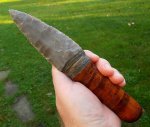
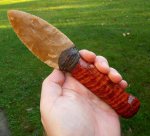
The above knife is made with Coastal Plains Chert for Georgia with a faux curly maple handle. It looks like some of my pine pitch glue is there as well. A note on the faux curly process. A lot of the old rifle makers used to stain their gun stocks with a fake curly pattern. Curly maple is expensive today and back then it was harder to come buy. This was a way to get the same look if you didn't have the premium material.
Every so often I get an order for a flint knife that a hunter can use to skin his elk or deer. This is quite a different project from the show, sit on a shelf knives. This type of knife must be hearty, have its bindings and hafting process be unaffected by the blood and juices of processing a fresh killed animal. The knife also must be wide to accommodate many resharpenings and last for a very long time. I offer the free service of resharpening such knives if the customer ships them to me or if local, stops by. A family of elk hunters in Montana all have my flint knives and they just love them. I've also processed my own deer before with my flint knife and hands down, nothing takes the hide off an animal cleaner than a flint knife. My brother was skeptical so I made him one and he swears by it now as well. Here are a few of those:

The above is Texas Georgetown flint, which in my opinion is one of the best types for hunting / skinning knives due to it's durability. The bindings are all covered with pine pitch glue so that the animal's blood doesn't loosen the sinew or gut hafting.
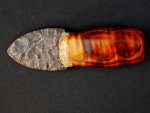
The above knife was one of the Montana family knives. I make mine with chubby handles so you can have a good grip. This one has an Onondaga Flint blade and a curly ash handle. If I had my choice, this one would be it. Notice how it is not showy, but every aspect of it is about function. It more resembles what we find artifact wise.
Here's another Montana family knife. Texas Georgetown flint again with a curly ash handle and bee's wax over the sinew hafting. I wonder how many elk they have skinned up and processed?
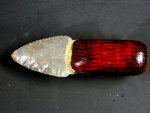
A knife like this I imagine would have been carried in a pouch. The white contact people really passed on the idea of a knife sheath, but I really truly believed they were carried traditional by the Native Americans in a pouch or bag of some kind. A knife like this would have been a pretty poor offensive or defensive weapon.


The above knife is made with Coastal Plains Chert for Georgia with a faux curly maple handle. It looks like some of my pine pitch glue is there as well. A note on the faux curly process. A lot of the old rifle makers used to stain their gun stocks with a fake curly pattern. Curly maple is expensive today and back then it was harder to come buy. This was a way to get the same look if you didn't have the premium material.
Every so often I get an order for a flint knife that a hunter can use to skin his elk or deer. This is quite a different project from the show, sit on a shelf knives. This type of knife must be hearty, have its bindings and hafting process be unaffected by the blood and juices of processing a fresh killed animal. The knife also must be wide to accommodate many resharpenings and last for a very long time. I offer the free service of resharpening such knives if the customer ships them to me or if local, stops by. A family of elk hunters in Montana all have my flint knives and they just love them. I've also processed my own deer before with my flint knife and hands down, nothing takes the hide off an animal cleaner than a flint knife. My brother was skeptical so I made him one and he swears by it now as well. Here are a few of those:

The above is Texas Georgetown flint, which in my opinion is one of the best types for hunting / skinning knives due to it's durability. The bindings are all covered with pine pitch glue so that the animal's blood doesn't loosen the sinew or gut hafting.

The above knife was one of the Montana family knives. I make mine with chubby handles so you can have a good grip. This one has an Onondaga Flint blade and a curly ash handle. If I had my choice, this one would be it. Notice how it is not showy, but every aspect of it is about function. It more resembles what we find artifact wise.
Here's another Montana family knife. Texas Georgetown flint again with a curly ash handle and bee's wax over the sinew hafting. I wonder how many elk they have skinned up and processed?

A knife like this I imagine would have been carried in a pouch. The white contact people really passed on the idea of a knife sheath, but I really truly believed they were carried traditional by the Native Americans in a pouch or bag of some kind. A knife like this would have been a pretty poor offensive or defensive weapon.
Last edited:
jbreakfield
Jr. Shave Member
More knives.............................Below is a Texas Georgetown flint blade with a curly ash handle and gut hafting. A word on gut hafting......I use pig intestines which are what your fine sausages, hot dogs, brats, etc. are cased with. If it says natural casing, yup that's intestines. I used to work a lot with sinew and it is an excellent hafting material, but you don't get a lot of it per animal. If you think about it, there's something like 50 or more yards of small intestine in animals like deer and elk so that's far more plentiful than the sinew. Once dried, the intestines can be stored, then soaked and they become pliable again just like they were when in the animal. I get mine from a butcher and they come nice and clean and mildly stored in saline solution. I freeze them and use them as needed. Rinsing them out before using them is always fun when you have a sink full of bloated entrailsGood thing I have a shop sink and don't have to do this in the house!
View attachment 30844
View attachment 30846
The above knife is made with Coastal Plains Chert for Georgia with a faux curly maple handle. It looks like some of my pine pitch glue is there as well. A note on the faux curly process. A lot of the old rifle makers used to stain their gun stocks with a fake curly pattern. Curly maple is expensive today and back then it was harder to come buy. This was a way to get the same look if you didn't have the premium material.
Every so often I get an order for a flint knife that a hunter can use to skin his elk or deer. This is quite a different project from the show, sit on a shelf knives. This type of knife must be hearty, have its bindings and hafting process be unaffected by the blood and juices of processing a fresh killed animal. The knife also must be wide to accommodate many resharpenings and last for a very long time. I offer the free service of resharpening such knives if the customer ships them to me or if local, stops by. A family of elk hunters in Montana all have my flint knives and they just love them. I've also processed my own deer before with my flint knife and hands down, nothing takes the hide off an animal cleaner than a flint knife. My brother was skeptical so I made him one and he swears by it now as well. Here are a few of those:
View attachment 30847
The above is Texas Georgetown flint, which in my opinion is one of the best types for hunting / skinning knives due to it's durability. The bindings are all covered with pine pitch glue so that the animal's blood doesn't loosen the sinew or gut hafting.
View attachment 30848
The above knife was one of the Montana family knives. I make mine with chubby handles so you can have a good grip. This one has an Onondaga Flint blade and a curly ash handle. If I had my choice, this one would be it. Notice how it is not showy, but every aspect of it is about function. It more resembles what we find artifact wise.
Here's another Montana family knife. Texas Georgetown flint again with a curly ash handle. I wonder how many elk they have skinned up and processed?
View attachment 30849
A knife like this I imagine would have been carried in a pouch. The white contact people really passed on the idea of a knife sheath, but I really truly believed they were carried traditional by the Native Americans in a pouch or bag of some kind. A knife like this would have been a pretty poor offensive or defensive weapon.
This is amazing work! Very impressive!
I've been quite busy lately between working on special orders and the cabin, but here are pictures of my latest complete order. They will be part of the Davis Collection in TN. Now I can turn my full attention to finishing up a TSC member's special knife and sheath order.

Above is a pretty large antler handled knife. The blade was in the 6 inch plus range. I've had this antler around for a while and didn't like the shape of it, but when you have knife blades finished you take them "handle shopping" by bringing out my bins of antlers to see what fits. This one fits perfectly in the hand for this type of dovetail blade. I got lucky and this one balances perfectly like it should. The blade is heat treated Burlington Chert from Missouri.

This one is also Burlington Chert, but of the creek pebble variety. The creek pebble type absorbs a lot of minerals, hence all the color. This has about a 4 3/4 inch blade and is a Hopewell type point. The antler was left just like it was at the request of the customer who cut it himself off one of his own deer.
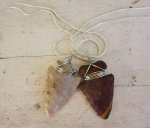
Above are two necklaces. Very simple designs are the best. I'm not the most talented wire wrapper and am used to more traditional materials, but they came out pretty good. The dark point is Horse Creek Chert from TN and the other point is Flint Ridge from Ohio.

Above is a pretty large antler handled knife. The blade was in the 6 inch plus range. I've had this antler around for a while and didn't like the shape of it, but when you have knife blades finished you take them "handle shopping" by bringing out my bins of antlers to see what fits. This one fits perfectly in the hand for this type of dovetail blade. I got lucky and this one balances perfectly like it should. The blade is heat treated Burlington Chert from Missouri.

This one is also Burlington Chert, but of the creek pebble variety. The creek pebble type absorbs a lot of minerals, hence all the color. This has about a 4 3/4 inch blade and is a Hopewell type point. The antler was left just like it was at the request of the customer who cut it himself off one of his own deer.

Above are two necklaces. Very simple designs are the best. I'm not the most talented wire wrapper and am used to more traditional materials, but they came out pretty good. The dark point is Horse Creek Chert from TN and the other point is Flint Ridge from Ohio.
SOOOOO AMAZED at your work! Seriously though...such wonderful craftsmanship!
Thanks everyone for your kind comments. Those items began their journey to their new home in TN today.
This knife went out to one of our very own TSC members! I'll let him chime in if he wants to identify himself. He might even have better pictures than these. It's a Keokuk Burlington Chert blade with lightening veins running through it, hafted onto a deer leg bone handle with pine pitch glue and gut lashings. The "scrimshaw" are copies of petroglyphs found in Death Valley. The sheath was made to order and is more of the cowboy type of look which is what was requested. Enjoy






Holy mother of Stone Blade Batman!!! beautiful
Thanks everyone. I sure do love making knives like this one! Winter time is a bit slower for me so fall is a good time to put in a knife order. If anyone is interested, send me a personal message and we can work something out. I start taking Christmas orders this time of year and once the slots are filled for what I think I can get done and mailed out in time for Christmas, they are filled until after the new year. Forging stops when the outside temps dip below 40 degrees.
kf5gtc
Shave Newbie
I do a little Cowboy Action Shooting with the Single Action Shooting Society out here in Texas.
This is some of the kit this knife will be spending it's life with. The knife made it all the way to Texas and will be the envy of all my cowboy friends.
I was asked plenty of questions to make sure I got something that was really special to me. I feel like it really was a collaboration between patron and artisan. (Mostly I let the artist have free reign.)
The knife is so pretty that now I have to build a display case for it.

This is some of the kit this knife will be spending it's life with. The knife made it all the way to Texas and will be the envy of all my cowboy friends.
I was asked plenty of questions to make sure I got something that was really special to me. I feel like it really was a collaboration between patron and artisan. (Mostly I let the artist have free reign.)
The knife is so pretty that now I have to build a display case for it.


